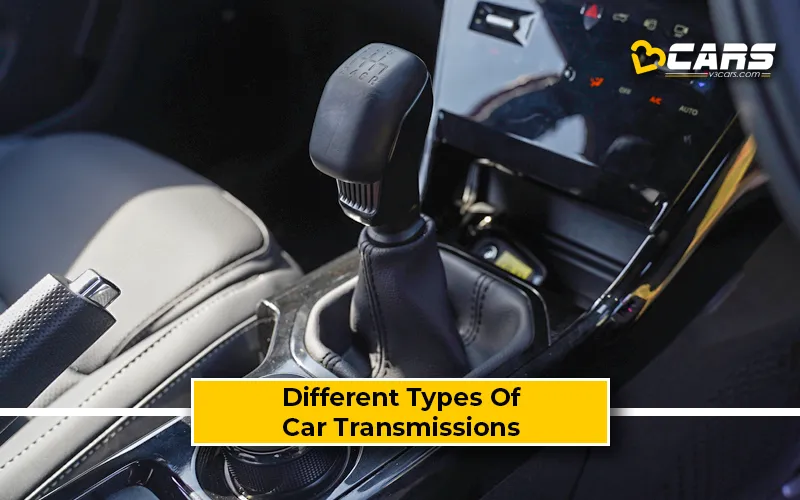Different Types Of Transmissions In Cars For India – V3Cars Guide
When it comes to driving, the transmission in your car plays a pivotal role in delivering power from the engine to the wheels. Over the years, automotive engineering has given rise to a diverse array of transmission types, each with its unique characteristics and advantages. In this comprehensive guide, we will delve into the different types of car transmissions. We’ll take a closer look at car transmissions ranging from the classic manual to the advanced automatic options like AMT, CVT, DCT, and more. By the end of this article, you'll have a clear understanding of the different types of transmissions available in today's automotive market.

Manual Transmission (MT)
Manual transmissions, also known as stick shifts, require the driver to manually select and engage gears using a clutch pedal and gear shifter. They offer complete control over gear selection and are often favoured by driving enthusiasts for their engagement and efficiency. Now, you might have come across terms like “5-speed manual transmission” or “6-speed MT” in our reports.
The terms "5-speed" and "6-speed" in a manual transmission refer to the number of forward gears that the transmission provides. These numbers indicate the different gear ratios available for the driver to select while operating the vehicle. Each gear offers a specific ratio of engine speed (measured in revolutions per minute, or RPM) to wheel speed, allowing the driver to optimise the vehicle's performance under various driving conditions. Here's a breakdown of what "5-speed" in a manual transmission:
- A 5-speed manual transmission has 5 forward gears and one reverse gear that the driver can shift between.
- These gears typically include a 1st gear for low-speed, high-torque situations (e.g., starting from a complete stop), a 2nd gear for accelerating further, a 3rd gear for moderate-speed driving, a 4th gear for higher speed, and a 5th gear for highway cruising and fuel-efficient driving.
- The presence of a 5th gear allows for a more extended range of speed options and better fuel efficiency compared to a 4-speed manual transmission.
The specific gear ratios in a manual transmission are designed to match the engine's power and torque characteristics, as well as the intended purpose of the vehicle. A greater number of gears allows for more precise control over the engine's output, which can enhance both performance and fuel efficiency. However, the choice between a 5-speed and 6-speed manual transmission often depends on the vehicle's design and intended use, as well as driver preference for shifting dynamics and fuel economy.
Note: Now Find Out The Fuel Price In India Using V3Cars
Automatic Transmission (AT)
Automatic transmissions come in various forms, such as torque converter (TC), continuously variable transmission (CVT), dual-clutch automatic transmission (DCT), and more. Transmission options such as automated manual transmission (AMT) and intelligent manual transmission (iMT) also come under the umbrella of automatic transmission, although the way they function is different from a conventional automatic transmission. Automatic transmissions are known for their ease of use, especially in stop-and-go city traffic conditions.
Here, we’ll look at the various types of automatic transmissions that are available in India.
1. Torque Convertor (TC)
Torque converter automatic transmissions, often referred to simply as automatic transmissions, have been a standard feature in many vehicles for decades. They come with their own set of advantages and disadvantages. A torque converter automatic transmission uses hydraulic coupling via the torque converter to transmit power from the engine to the transmission and ultimately to the wheels. The torque converter allows for smooth and variable torque transfer, making it well-suited for a wide range of driving conditions. The transmission's internal gears and clutches control the vehicle's speed and power output, while the lock-up clutch and modern electronic controls improve efficiency and drivability.
2. Continuously Variable Transmission (CVT)
A continuously variable transmission (CVT) is an automatic transmission type that doesn't use traditional gears like a manual transmission or a conventional torque converter with stepped gear ratios. Instead, a CVT employs a belt and pulley system to provide seamless, stepless gear ratios.
The belt and pulley system provides a continuously variable range of gear ratios, resulting in a smooth and efficient driving experience. It's a technology known for its fuel efficiency and smoothness, making it popular in many modern vehicles, particularly in small cars and hybrids. However, it may not offer the same engagement as traditional transmissions, and the "rubber-band" effect can be a drawback for some drivers. Advances in CVT technology continue to improve their performance and refinement.
But what is this “rubber-band” effect that we speak of? Some drivers describe a sensation known as the "rubber-band" effect, where the engine revs up quickly when accelerating but takes time to catch up with the vehicle's speed. This sensation can be bothersome to some and may feel less responsive.
Now, you may have come across the term eCVT in the Honda City e:HEV strong hybrid sedan. Here, the ‘e’ stands for the electric motor that helps the CVT put down power in a smoother manner while also improving the overall fuel efficiency.
3. Dual-Clutch Transmission (DCA, DCT, DSG)
A dual-clutch transmission, also known as DCT, DCA, DSG, etc., is a type of automated manual transmission that combines the convenience of an automatic with the efficiency and performance of a manual transmission. DCTs are commonly found in many high-performance and sports cars, as well as some mainstream vehicles such as the Tata Altroz DCA, Volkswagen Virtus, etc.
A dual-clutch transmission uses 2 clutches and a sophisticated control system to provide fast, smooth, and efficient gear changes. While they offer many advantages, they are more complex and can be less forgiving at low speeds than traditional automatic transmissions.
4. Automated Manual Transmission (AMT)
AMTs are essentially manual transmissions with an automated clutch and gear-shifting mechanism. It combines the convenience of an automatic transmission with the cost-effectiveness of a manual transmission. AMTs have gained popularity in various vehicles over the years. Some of the popular AMT models in India include the Maruti Suzuki Celerio, Tata Tiago and Nexon, etc. Different carmakers like to call an AMT by different names. For instance, Maruti calls their version of the AMT as AGS, or Automatic Gear Shift Technology.
AMTs are known for their affordability and ease of use. They also help reduce driver fatigue in traffic and improves fuel efficiency as well. They have low maintenance costs when compared to conventional automatic transmissions and most AMT-equipped cars sold in India these days come with hill-hold assist that prevents the car from rolling backwards when starting on an incline. However, AMTs have certain downsides as well, such as jerky shifts, slower response times and limited gear control when compared to a manual transmission.
5. Auto-Clutch Manual Transmission (ACMT, iMT)
Auto-clutch manual transmissions iMTs combine a manual gearbox with an electronically controlled clutch. They offer manual gear selection with the convenience of an automatic clutch. Hyundai and Kia like to call their version of the ACMT as the iMT, or intelligent manual transmission. This technology effectively eliminates the need for the clutch pedal, reducing a significant aspect of driver-car interaction. It operates through a combination of an advanced intention sensor, a hydraulic clutch actuator, and an electronic transmission control unit. These components are integrated with a standard H gearbox.
In simpler terms, the iMT transmission streamlines the driving experience by removing the clutch pedal and utilising sensors to engage the built-in clutch, while gear shifting remains under the driver's control.
Note: Instantly Sell Your Old Car With V3Cars Sell Used Car Platform
Also Read: Different Types Of Car Engines Explained



0 Comments